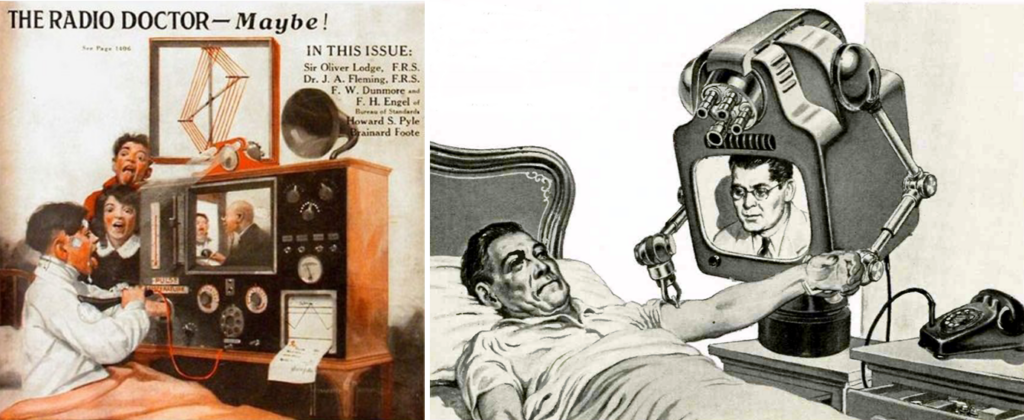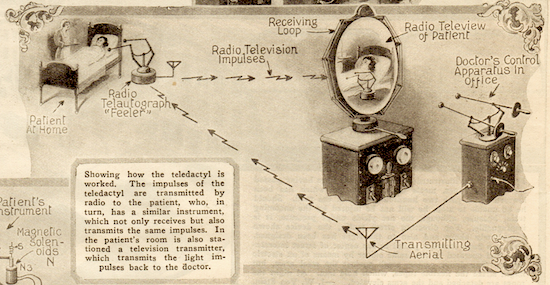Telehealth’s time has come
The story of telehealth is more than a tale of technology catching up to imagination — it’s a case study in how strategy, storytelling, and communication converge to make the complex feel possible.
From early sci-fi sketches to pandemic-era animations, visuals have always played a critical role in helping people understand unfamiliar systems like remote care. At Tremendousness, we use the same approach to help organizations explain the future — whether it’s a new service, a complex change, or a shift in how we care for others.
Yes, telehealth is taking off now — but it sure has taken a while. In fact, one of the first mentions of the practical potential uses of telemedicine dates back to 1924. The April issue of Radio News magazine featured a cover story called “The Radio Doctor—Maybe!”. Well, cover story may be overstating the case. While the illustration (above left) is a semi-recognizable, Normal Rockwell-like scene, the article itself was more of a short, strange fiction and less of a prediction.
A better vision came the next year in the February, 1925 issue of Science and Invention. Sci-fi legend (and crook) Hugo Gernsback predicted “The Teledactyl” (below right), a potential sensory feedback device that might enable a doctor to use medical instruments from afar.
Then, 30 years later, Television magazine again imagined remote doctoring via “The Teledoctor” (above right). The Gernsback scenes in that February 1955 issue also are recognizable, and essentially have come true as well—though only in special cases.
But it’s the Radio News vision that we’re seeing more and more of as the world navigates the COVID-19 pandemic. Simply being able to see and talk to a doctor live on video without leaving your home is a leap forward, one nearly 100 years in the making.
And to me it’s really interesting just how key visuals are in all of these stories. The illustrations and infographics in all three vintage magazines make real a quite unimaginable scenario—visiting with your doctor when you can’t be with your doctor. That’s one of the great powers of visual storytelling: it can help people understand things that don’t yet exist or are hard to explain.
Several years ago when we worked with our friends at AARP‘s ASI division to create a series of animations explaining the value of a variety of developing services that benefit caregivers and their older loved ones. This included Telehealth (see video below). While the messaging here is directed solely at caregivers, the service obviously is valuable for anyone needing to see a doctor but limited in their ability to go or be out in the world.
Today, that’s happening more and more as people live longer, rural hospitals close, and medical facilities get overwhelmed. Sure, there are no mechanical or robotic arms in our explanatory animation, but the point is clear: a version of this particular future has finally arrived.
And it’s about time. Forget for a moment that smoke signals and light reflection and drums once alerted ancient communities of coming plagues and other news, and know that it was only back in 1959 that this high-tech reality truly began to take shape. When the University of Nebraska transmitted live neurological examination images across campus the world experienced what is generally considered the first real-time video telemedicine consultation. Other experiments and programs followed, but all were limited by highly specialized, very expensive equipment. Sure, it was telemedicine by definition, but it simply could not be done at home.
Now, as we shelter-in-place, telemedicine is enabling more and more people to make some doctor’s visits—from our own houses and apartments and care facilities. Physical examination and testing is, of course, limited, but as the video says, “telehealth is the 21st century version of the house call”. And we certainly need it these days.
Illustrations (left) from Radio News, (right) from Radio Electronics, and (middle) from Science and Invention. Animation by Tremendousness for ASI.

